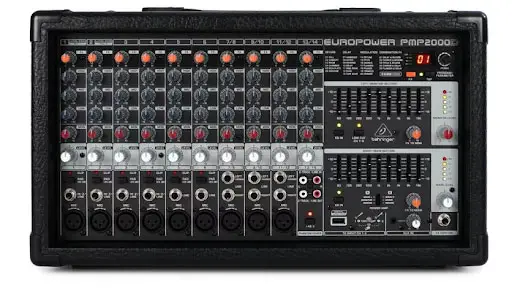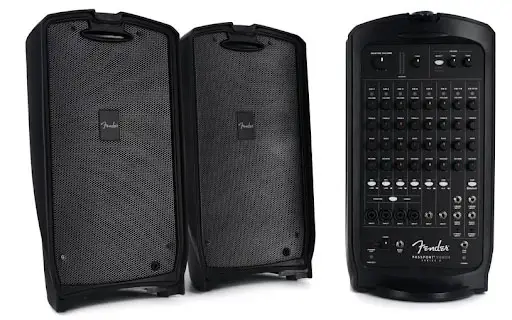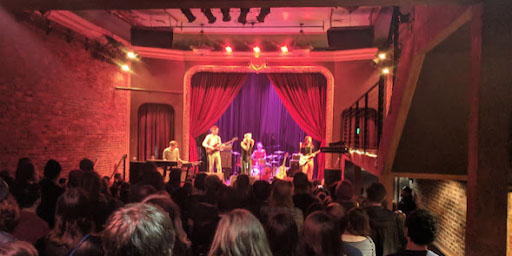A PA, or public address system, is a collection of speakers and electronic devices used to project audio, typically from a microphone. PA systems are absolutely integral to any live performance and play a massive role in the audience’s listening experience.
If a PA system is too loud or not loud enough, the audience will notice — and not in a good way. Not only that, not having the right set up can mean you don’t have all the microphone inputs you need or you may not be able to adjust EQ settings for your acoustic surroundings.
Whether you’re a local band that needs a portable PA system for playing small gigs or a music venue looking for a more permanent solution, choosing the right PA is vital to providing a good listening experience for your audience.
In this guide, we’ll cover the basics of PA systems, the difference between active and passive speakers, how much PA systems cost, how much wattage you need, and anything else you need to know in order to choose the perfect PA for you.
Table Of Contents
How Does a PA System Work?
The standard PA system consists of two cabinet speakers, each with a large driver called a subwoofer and a smaller driver called a tweeter for higher frequencies. Additionally, there is a mixer and an amplifier as well.
The amp provides the power necessary for the cabinets (some cabinets have built-in amps), and the mixer allows the user to control the PA’s tone, volume, effects and more.
The most common audio source for a PA system is a microphone. These microphones can be vocal, instrument, or room mics. Pre-recorded audio is also commonly played through a PA as well. The way the system works begins with the audio source such as a microphone. The audio then goes through the mixer, then the amplifier, and finally through the speakers.
Powered (Active) vs. Unpowered (Passive) Speakers
A powered, or active speaker contains an amplifier built into the cabinet. An unpowered, or passive speaker does not contain an amplifier. A powered speaker is more convenient, as it combines two components into one. Additionally, the built-in amplifier is already calibrated to the speaker, meaning no fine tuning power adjustments are required to achieve the desired sound.
Many musicians prefer passive speakers to active because it allows them greater control of the audio. With powered speakers, you’re more or less forced to use identical stereo cabinet speakers. But with an unpowered setup, you’re able to use different brands of speakers and connect them all to the same external amplifier.

Powered vs. Unpowered Mixers
Just like speakers, mixers come in two main options as well: Powered (active) and unpowered (passive). The pros and cons are similar as well. Powered mixers weigh much more than unpowered mixers but take less time and effort to set up.
Unpowered mixers are considered to be the more higher-end of the two, with the majority of big concert setups using them. The main reason for this is the level of control you get with an external amplifier working in tandem with the mixer. This means you can adjust the gain and other settings on both the amp and the mixer, allowing you to fine tune more.

How Much Does a PA System Cost?
There are several factors that go into determining the price of PA systems, but on a broad spectrum a PA system will cost you anywhere from $200 to $3,000+.
The main variables when it comes to different types of systems are portability, and the amount of built-in features.
Many speakers are all-in-one PA systems with their own amp and mixer included! Typically, the column PA systems will have everything built-in. They are, however, on the pricier side compared to other all-in-one systems, as well as only a singular audio source compared to a stereo.

Lower priced systems can be bought for as low as $200. They aren’t a column, but simply a large, single speaker that has a built-in amp and mixer. They are very portable and easier to set up, but do not offer a whole lot of sound (unless you have several of them). Although, one of them will do just fine in a coffee shop or a small school assembly.
Some of the most popular systems are in about the middle of the average price range ($800-$1,000) and consist of two portable speaker cabinets with built-in amplifiers and an external, powered mixer.
How Much Wattage Will You Need in Your System?
If you are putting on a rock show in an average-sized club (about 1,000-2,000 people), your PA system will need roughly 1,500 watts. A jazz combo in that same venue would only need around 500 watts. A coffee shop singer-songwriter may only require a PA system with 60 watts! If you’re putting on a large outdoor festival show, you will easily need 4,000+ watts.
Watts are a measure of electrical power and the larger the venue and audience, the more wattage you’ll need. You must keep that in mind when determining which components to purchase.
Should You Buy a PA System as a Package or Individual Components?
It is very common to see PA system packages for sale as they are convenient and can be cheaper than buying each part separately. Building your system yourself, however, comes with advantages of its own. It all comes down to what you will be using it for.
The most versatile option would be a common package that includes two powered cabinets and an external mixer. This package is ideal for any typical bar/club gig. It is portable, easy to set up, and has more than enough wattage for those kinds of venues.
Venues and more experienced performers, who are playing larger shows with larger crowds, are much more inclined to build their PA system through individual components. The ability to totally customize the amplifiers, and to add more components to the system such as effects is extremely useful.

The Best PA Systems for Gigging Bands
| Image | Description | Features | Price |
|---|---|---|---|
 | The Fender Passport Venue S2 is a great option for a gigging band at a decent but slightly higher price point. It is extremely portable, with both speakers able to lock onto the mixer to create a single package with a handle that is very easy to carry on and off stage. | 9.5 | Check Price On SweetwaterCheck Price On Amazon |
 | The Samson Expedition XP1000 is an interesting alternative to the Fender Venue. It is cheaper, more powerful but slightly less portable. It also features a built-in amplifier and an external mixer. | 9.5 | Check Price On Sweetwater |
 | The Behringer Europort PPA2000BT has 2,000 watts from its built-in amplifier, giving you enough power for really any situation a gigging band may find themselves in. It also features built-in effects as well as Bluetooth capability. | 9.5 | Check Price On SweetwaterCheck Price On Amazon |
As a gigging band, it is necessary to have access to your own PA system since not every venue will have a system that suits your needs. Gigging bands will generally need a PA system that is both relatively portable and not too expensive.
The best type of PA system for gigging bands will typically be the bundles discussed in the previous section. A powered, two-speaker system with an external mixer. Here are several options that are excellent for a gigging band.
1. Fender Passport Venue S2 – 600 Watts

The Fender Passport Venue S2 is a great option for a gigging band at a decent but slightly higher price point. It is extremely portable, with both speakers able to lock onto the mixer to create a single package with a handle that is very easy to carry on and off stage.
It features plenty of inputs and is very lightweight, the whole package in total weighing just over fifty pounds. It will do just fine in most gig settings, however if you are in an especially loud rock or metal band, the 600w may not fill the room as much as you may need. It does, however, have the ever reliable Fender name.
Key Specs
| Watts: | 600 |
| Bluetooth: | Yes |
| Built-In Amplifier: | Yes |
| Inputs: | 13 total. 4 XLR ¼”, 2 instrument ¼”, 2 stereo ¼”, 2 stereo ⅛”, stereo bluetooth |
| Warranty: | No |
| Case Included: | Built-in case |
| Customer Reviews: | 4.6 out of 5 stars (48 ratings) |
| Package Dimensions: | 31.6 in. x 24.8 in. x 14.5 in. (802.64 mm x 629.92 mm x 368.3 mm) |
| Package Weight: | 54.3 lb (24.63kg) |
2. Samson Expedition XP1000 – 1,000 Watts

The Samson Expedition XP1000 is an interesting alternative to the Fender Venue. It is cheaper, more powerful but slightly less portable. It also features a built-in amplifier and an external mixer. Unlike the Fender package, this model doesn’t fit together to form a case so the speakers need to be carried separately.
It also has one less input line, but it does feature a bluetooth USB mic port that can be used with a wireless Samson mic (sold separately). The speakers also feature built-in stand mounts so they can be easily fixed to speaker stands on the stage.
The Expedition boasts 400 watts more than the Fender model, so if you need more power and are willing to sacrifice some portability, this is a great product for you.
Key Specs
| Watts: | 1,000 |
| Bluetooth: | Yes |
| Built-In Amplifier: | Yes |
| Inputs: | 12 total. 4 XLR ¼”, 4 instrument ¼”, 2 stereo ¼”, 1 stereo ⅛”, stereo bluetooth |
| Warranty: | No |
| Case Included: | No |
| Customer Reviews: | 4.1 out of 5 stars (105 ratings) |
| Package Dimensions: | 22.7 in. x 22 in. x 12.6 in. (576.58 mm x 558.8 mm x 320.04 mm) |
| Package Weight: | 53 lb (24.04kg) |
3. Behringer Europort PPA2000BT – 2,000 Watts

The Behringer Europort PPA2000BT is the best deal of the three given its price point at $829. It has 2,000 watts from its built-in amplifier, giving you enough power for really any situation a gigging band may find themselves in.
It also features built-in effects as well as Bluetooth capability. It is heavy, however, over ten pounds more than the other two. That isn’t too much of a difference but it is still noticeably heavier.
This product truly is a great deal given the power and other features that it comes with.
Key Specs
| Watts: | 2,000 |
| Bluetooth: | Yes |
| Built-In Amplifier: | Yes |
| Inputs: | 12 total. 4 XLR ¼”, 4 instrument ¼”, 2 stereo ¼”, 1 stereo ⅛”, stereo bluetooth |
| Warranty: | No |
| Case Included: | No |
| Customer Reviews: | 4.5 out of 5 stars (57 ratings) |
| Package Dimensions: | 34.76 in. x 25.98 in. x 13.94 in. (882.9 mm x 659.89 mm x 354.08 mm) |
| Package Weight: | 68.3 lb (30.98kg) |
The Best PA Speakers for Small to Medium-Sized Venues
| Image | Description | Features | Price |
|---|---|---|---|
 | The powered JBL PRX825W is a very powerful speaker that will certainly help build a robust sound for your venue. | 9.5 | Check Price On Sweetwater |
 | This Electro-Voice speaker is a cheaper, lighter alternative to the JBL that will more than satisfy the needs of a small bar or modest-sized church. The wattage is 500 less per speaker so this is more ideal for smaller venues rather than medium-sized. | 9.5 | Check Price On SwetwaterCheck Price On Amazon |
 | The QSC KW153 is an excellent, professional quality speaker that will be great for any small to medium-sized venue. Unlike the previous two speakers which were two-way (subwoofer for low-end and tweeter for high-end), this model has three drivers for low, medium and high end, making it a three-way speaker. | 9.5 | Check Price On SweetwaterCheck Price On Amazon |
These venues, such as churches, bar,s and clubs require PA systems that are less focused on portability and more so on completely filling the room with sound. These venues are much more likely to buy individual components of a PA system rather than a bundle due to the fact that bundles are made for more portable purposes and have less power and customization than you can get by building your own PA system.
We will compare three different types of PA speakers that are perfect options for any small to medium venue.
1. JBL PRW825W – 15 Inch Speaker

The powered JBL PRX825W is a very powerful speaker that will certainly help build a robust sound for your venue. They are big, heavy, and not cheap. It is a highly-rated speaker known for its durability and impressive volume.
You will need at least two of these to create a PA system for your venue but the reliability and quality of these speakers will more than pay themselves.
Key Specs
| Watts: | 1,500 (single speaker) |
| Bluetooth: | No (uses wi-fi) |
| Built-In Amplifier: | Yes |
| Speaker Size: | 15” |
| Warranty: | No |
| Case Included: | No |
| Customer Reviews: | 4.7 out of 5 stars (100 ratings) |
| Package Dimensions: | 41.8 in. x 21.2 in. x 17.5 in. (1061.72 mm x 538.48 mm x 444.5 mm) |
| Package Weight: | 82 lb (37.19kg) |
2. Electro-Voice ZLX-15BT – 15 Inch Speaker

This Electro-Voice speaker is a cheaper, lighter alternative to the JBL that will more than satisfy the needs of a small bar or modest-sized church. The wattage is 500 less per speaker so this is more ideal for smaller venues rather than medium-sized.
It features Bluetooth connectivity as well as carrying handles and it is over half the weight of the JBL. This is a great product for a venue that needs to reconfigure it’s stage relatively often as they are easier to move than most cabinets.
Key Specs
| Watts: | 1,000 (single speaker) |
| Bluetooth: | Yes |
| Built-In Amplifier: | Yes |
| Speaker Size: | 15” |
| Warranty: | No |
| Case Included: | No |
| Customer Reviews: | 4.6 out of 5 stars (75 ratings) |
| Package Dimensions: | 27 in. x 17 in. x 15 in. (685.8 mm x 431.8 mm x 381 mm) |
| Package Weight: | 38 lb (17.24kg) |
3. QSC KW153 1000W – 15 Inch Three-Way Speaker

The QSC KW153 is an excellent, professional quality speaker that will be great for any small to medium-sized venue. Unlike the previous two speakers which were two-way (subwoofer for low-end and tweeter for high-end), this model has three drivers for low, medium and high end, making it a three-way speaker.
The richness of sound from the three-way speaker more than compensates for the lower wattage of 1,000. It doesn’t have some features such as Bluetooth or portability, but this cabinet will elevate your venue massively.
Key Specs
| Watts: | 1,000 (single speaker) |
| Bluetooth: | Yes |
| Built-In Amplifier: | Yes |
| Speaker Size: | 15” |
| Warranty: | No |
| Case Included: | No |
| Customer Reviews: | 5 out of 5 stars (43 ratings) |
| Package Dimensions: | 43.1 in. x 18.5 in. x 16.8 in. (1094.74 mm x 469.9 mm x 426.72 mm) |
| Package Weight: | 87 lb (39.46kg) |

The most important thing to remember when it comes to purchasing your PA system, whether as a bundle or in separate components, is that every musician or venue has different needs and must make their purchase with those needs in mind. If you do so, then your PA system absolutely will not let you down.


